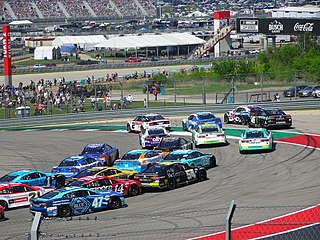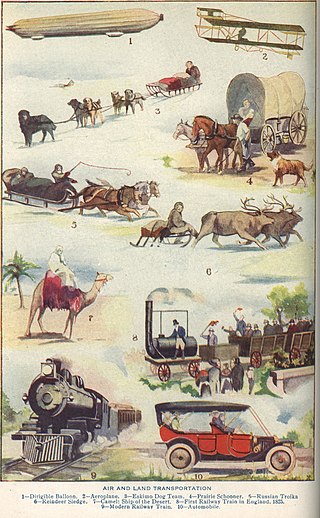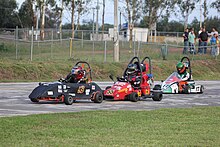
Auto racing is a motorsport involving the racing of automobiles for competition.

An open-wheel single-seater is a car with the wheels outside the car's main body, and usually having only one seat. Open-wheel cars contrast with street cars, sports cars, stock cars, and touring cars, which have their wheels below the body or inside fenders. Open-wheel cars are built both for road racing and oval track racing. Street-legal open-wheel cars, such as the Ariel Atom, are scarce as they are often impractical for everyday use.

A velomobile ; velomobiel, velo, or bicycle car is a human-powered vehicle (HPV) enclosed for aerodynamic advantage and/or protection from weather and collisions. Velomobiles are similar to recumbent bicycles, pedal go-karts and tricycles, but with a full fairing and are not to be confused with purpose-built mobiles for racing or speed records fully faired vehicles with two wheels, generally called streamliners. Streamliners have set many speed and distance records.

An electric vehicle (EV) is a vehicle that uses one or more electric motors for propulsion. It can be powered by a collector system, with electricity from extravehicular sources, or it can be powered autonomously by a battery. EVs include, but are not limited to, road and rail vehicles, surface and underwater vessels, electric aircraft, and electric spacecraft. For road vehicles, together with other emerging automotive technologies such as autonomous driving, connected vehicles, and shared mobility, EVs form a future mobility vision called Connected, Autonomous, Shared, and Electric (CASE) Mobility.

A streamliner is a vehicle incorporating streamlining in a shape providing reduced air resistance. The term is applied to high-speed railway trainsets of the 1930s to 1950s, and to their successor "bullet trains". Less commonly, the term is applied to fully faired upright and recumbent bicycles. As part of the Streamline Moderne trend, the term was applied to passenger cars, trucks, and other types of light-, medium-, or heavy-duty vehicles, but now vehicle streamlining is so prevalent that it is not an outstanding characteristic. In land speed racing, it is a term applied to the long, slender, custom built, high-speed vehicles with enclosed wheels.

Endurance racing is a form of motorsport racing which is meant to test the durability of equipment and endurance of participants. Teams of multiple drivers attempt to cover a large distance in a single event, with participants given a break with the ability to change during the race. Endurance races can be run either to cover a set distance in laps as quickly as possible, or to cover as much distance as possible over a preset amount of time.

The 24 Hours of Le Mans is an endurance-focused sports car race held annually near the town of Le Mans, France. It is widely considered to be one of the world's most prestigious races, and is one of the races—along with the Monaco Grand Prix and Indianapolis 500—that form the Triple Crown of Motorsport. Run since 1923, it is the oldest active endurance racing event in the world.

Nuna is the name of a series of crewed solar powered race cars that have won the World Solar Challenge in Australia seven times: in 2001, 2003, 2005, 2007, 2013, 2015 and 2017. The vehicles are built by students who are part of the "Brunel Solar Team" at the Delft University of Technology in the Netherlands, sponsored by Brunel.

An electric truck is an electric vehicle powered by batteries designed to transport cargo, carry specialized payloads, or perform other utilitarian work.
The Buckeye Bullet is a series of four experimental electric cars created by students from Ohio State University as a joint project with Venturi. The cars were designed to break the land speed record on the Bonneville Speedway, a salt flat just outside Wendover, Utah, United States. The team first achieved its goal in October 2004, at 271.737 mph (437.318 km/h) for the one mile world record, repeatedly increasing the record until setting a mile world record of 307.666 mph (495.140 km/h), in 2009, and a one kilometer world record of 341.264 mph (549.211 km/h), in 2016.

Electric motorcycles and scooters are plug-in electric vehicles with two or three wheels. Power is supplied by a rechargeable battery that drives one or more electric motors. Electric scooters are distinguished from motorcycles by having a step-through frame, instead of being straddled. Electric bicycles are similar vehicles, distinguished by retaining the ability to be propelled by the rider pedaling in addition to battery propulsion.
The Sunraycer was a solar-powered race car designed to compete in the World Solar Challenge, the world's first race featuring solar-powered cars. The Sunraycer was a joint collaboration between General Motors, AeroVironment, and Hughes Aircraft.

The energy efficiency in transport is the useful travelled distance, of passengers, goods or any type of load; divided by the total energy put into the transport propulsion means. The energy input might be rendered in several different types depending on the type of propulsion, and normally such energy is presented in liquid fuels, electrical energy or food energy. The energy efficiency is also occasionally known as energy intensity. The inverse of the energy efficiency in transport, is the energy consumption in transport.

Energy-efficient driving techniques are used by drivers who wish to reduce their fuel consumption, and thus maximize fuel efficiency. The use of these techniques is called "hypermiling".

The Lohner–Porsche Mixed Hybrid was the first gasoline-electric hybrid vehicle.

A solar car is a solar vehicle for use on public roads or race tracks. Solar vehicles are electric vehicles that use self-contained solar cells to provide full or partial power to the vehicle via sunlight. Solar vehicles typically contain a rechargeable battery to help regulate and store the energy from the solar cells and from regenerative braking. Some solar cars can be plugged into external power sources to supplement the power of sunlight used to charge their battery.
Solar car racing refers to competitive races of electric vehicles which are powered by solar energy obtained from solar panels on the surface of the car. The first solar car race was the Tour de Sol in 1985 which led to several similar races in Europe, US and Australia. Such challenges are often entered by universities to develop their students' engineering and technological skills, but many business corporations have entered competitions in the past. A small number of high school teams participate in solar car races designed exclusively for high school students.
Electric drag racing is a form of drag motor racing between electric vehicles.

Electric motorsport is a category of motor sport that consists of the racing of electric powered vehicles for competition, either in all-electric series, or in open-series against vehicles with different powertrains. Very early in the history of automobiles, electric cars held several performance records over internal combustion engine cars, such as land speed records, but fell behind in performance during the first decade of the 20th century.

Stella and its successors Stella Lux, Stella Vie and Stella Era are a series of solar racing family cars, built for the World Solar Challenge in Australia, sofar winning its Cruiser Class all four times it was held – in 2013, 2015, 2017 and in 2019. Stella is considered the world’s first solar-powered family car and was given the 'Best Technology Development' Award at the 8th annual Crunchies in San Francisco in 2015. Being the only competing vehicle with a license plate, the road registration of Stella contributed to the winning score in the races. The vehicles are designed and built by "Solar Team Eindhoven" (STE) — some 26 students of different faculties of the Eindhoven University of Technology (TU/e) in the Netherlands. The group have set up a non-profit foundation to promote their concepts for practical solar vehicles for adoption on a broader scale.
















